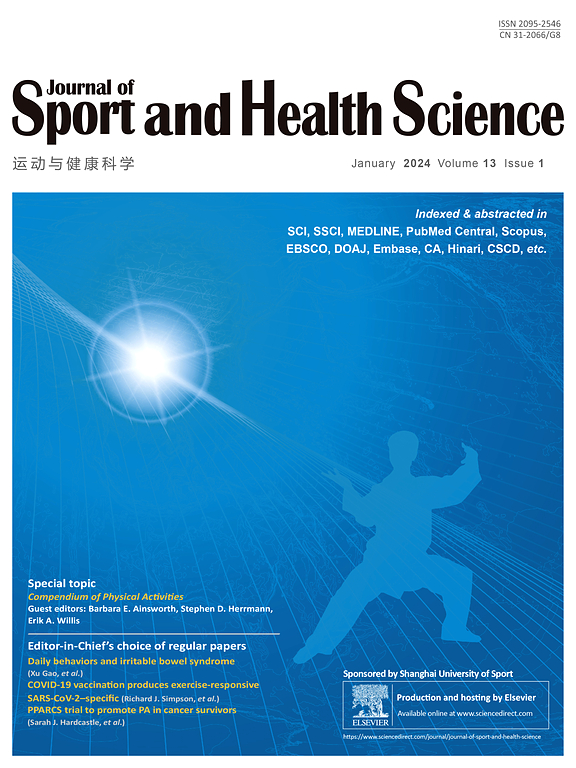Adaptations in mitochondrial quality control and interactions with innate immune signaling within skeletal muscle: A narrative review
IF 10.3
1区 医学
Q1 HOSPITALITY, LEISURE, SPORT & TOURISM
引用次数: 0
Abstract
Skeletal muscle health and function are essential determinants of metabolic health, physical performance, and overall quality of life. The quality of skeletal muscle is heavily dependent on the complex mitochondrial reticulum that contributes toward its unique adaptability. It is now recognized that mitochondrial perturbations can activate various innate immune pathways, such as the nucleotide-binding oligomerization domain (NOD)-like receptor protein 3 (NLRP3) inflammasome complex by propagating inflammatory signaling in response to damage-associated molecular patterns (DAMPs). The NLRP3 inflammasome is a multimeric protein complex and is a prominent regulator of innate immunity and cell death by mediating the activation of caspase-1, pro-inflammatory cytokines interleukin-1β and interleukin-18 and pro-pyroptotic protein gasdermin-D. While several studies have begun to demonstrate the relationship between various mitochondrial DAMPs (mtDAMPs) and NLRP3 inflammasome activation, the influence of various metabolic states on the production of these DAMPs and subsequent inflammatory profile remains poorly understood. This narrative review aimed to address this by highlighting the effects of skeletal muscle use and disuse on mitochondrial quality mechanisms including mitochondrial biogenesis, fusion, fission and mitophagy. Secondly, this review summarized the impact of alterations in mitochondrial quality control mechanisms following muscle denervation, aging, and exercise training in relation to NLRP3 inflammasome activation. By consolidating the current body of literature, this work aimed to further the understanding of innate immune signaling within skeletal muscle, which can highlight areas for future research and therapeutic strategies to regulate NLRP3 inflammasome activation during divergent metabolic conditions.线粒体质量控制的适应性和骨骼肌内先天免疫信号的相互作用:一个叙述性的回顾
骨骼肌的健康和功能是代谢健康、身体表现和整体生活质量的重要决定因素。骨骼肌的质量在很大程度上依赖于复杂的线粒体网,这有助于其独特的适应性。现在人们认识到,线粒体扰动可以激活各种先天免疫途径,如核苷酸结合寡聚化结构域(NOD)样受体蛋白3 (NLRP3)炎性体复合物,通过传播炎症信号来响应损伤相关分子模式(DAMPs)。NLRP3炎性小体是一种多聚体蛋白复合物,通过介导caspase-1、促炎细胞因子白介素-1β和白介素-18以及促热噬蛋白gasderin - d的激活,是先天免疫和细胞死亡的重要调节因子。虽然一些研究已经开始证明各种线粒体DAMPs (mtDAMPs)和NLRP3炎性体激活之间的关系,但各种代谢状态对这些DAMPs的产生和随后的炎症特征的影响仍然知之甚少。本文旨在通过强调骨骼肌使用和废弃对线粒体质量机制的影响,包括线粒体生物发生、融合、裂变和线粒体自噬,来解决这一问题。其次,本综述总结了肌肉去神经支配、衰老和运动训练后线粒体质量控制机制的改变对NLRP3炎症小体激活的影响。通过整合现有的文献,本研究旨在进一步了解骨骼肌内的先天免疫信号,这可以突出未来的研究领域和治疗策略,以调节不同代谢条件下NLRP3炎性体的激活。
本文章由计算机程序翻译,如有差异,请以英文原文为准。
求助全文
约1分钟内获得全文
求助全文
来源期刊

Journal of Sport and Health Science
SPORT SCIENCES-
CiteScore
18.30
自引率
1.70%
发文量
101
审稿时长
22 weeks
期刊介绍:
The Journal of Sport and Health Science (JSHS) is an international, multidisciplinary journal that aims to advance the fields of sport, exercise, physical activity, and health sciences. Published by Elsevier B.V. on behalf of Shanghai University of Sport, JSHS is dedicated to promoting original and impactful research, as well as topical reviews, editorials, opinions, and commentary papers.
With a focus on physical and mental health, injury and disease prevention, traditional Chinese exercise, and human performance, JSHS offers a platform for scholars and researchers to share their findings and contribute to the advancement of these fields. Our journal is peer-reviewed, ensuring that all published works meet the highest academic standards.
Supported by a carefully selected international editorial board, JSHS upholds impeccable integrity and provides an efficient publication platform. We invite submissions from scholars and researchers worldwide, and we are committed to disseminating insightful and influential research in the field of sport and health science.
 求助内容:
求助内容: 应助结果提醒方式:
应助结果提醒方式:


